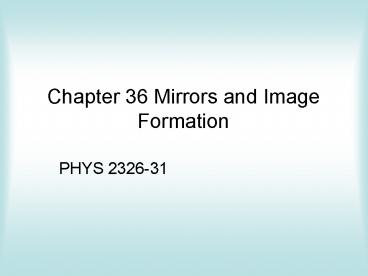Chapter 36 Mirrors and Image Formation PowerPoint PPT Presentation
1 / 20
Title: Chapter 36 Mirrors and Image Formation
1
Chapter 36 Mirrors and Image Formation
PHYS 2326-31
2
Concepts to Know
- Mirrors
- Plane, Concave, Convex
- Sign Conventions
- Object Distance
- Image Distance
- Focal Length
- Magnification
3
Concepts to Know
- Enlarged, Reduced
- Erect, Inverted
- Real, Virtual
- Reversed (Perverted)
- Converging, Diverging
- Aberration
- Principle Rays
4
Definitions
- Plane surface one that is flat
- Concave surface, one that is curved inward at the
center - Convex surface, one that is curved outward
Eye
Plane
Concave
Convex
5
Objects Images
- Image from a Plane Mirror
- p object to surface, q surface to image
- h object height, h image height
- Magnification M 1 for flat mirror
p
q
h
h
?
Object
?
Image
6
Images
- Virtual Image - no light reaches image
- Real Image - light rays reach image
- Erect or Upright Image directions unchanged
(object up is same direction as image up) - Inverted Image directions opposite (object up
is image down) - Reversed Image left seems right
7
Spherical Mirrors
- Parameters of a spherical mirror
- Principal axis line through C and V where V is
the center of the mirror - C Center of Curvature center of sphere or
circle (2 dimensions) - R Radius of Curvature
- F Focal point
- Radius lines are always
- normal to surface
- of circles and spheres
V
R
C
principal axis
F
Concave
8
- Given an object to the left of C, by the law of
reflection, ? ?, light rays will converge at a
point between V and C for rays with small angles
to the principal axis - For larger angles the rays will intersect at
different points creating spherical aberration
See Fig. 36.8
V
C
principal axis
O
I
Concave
9
Image Concave Mirror
- Rays through C are normal to surface ?0
- Draw rays to V (intersection of surface and
principal axis) ? ? and through C, ?0 - Tan ? h/p -h/q, since M h/h, -q/p
- Note -h inverted
- Image is
- smaller
- inverted
- real
- outside point F
Concave
p
R
h
V
?
a
a
h
C
?
F
q
10
- since tan a -h/(R-q) h/(p-R)
- h/h -(R-q)/(p-R) eqn 36.3
- 1/p 1/q 2/R eqn 36.4 MIRROR EQN
- For a very distant object where p-gt infinity, 1/p
0 so 1/q 2/R - This case it is called the focal point F, where F
2/R eqn 36.5 - hence 1/p 1/q 1/f, eqn 36.6, the mirror
equation - The focal point is where rays parallel to the
axis pass through
11
Spherical Convex Mirror
- Often called a diverging mirror
- Concepts presented are valid for this type of
mirror as well if adhere to the following
procedure - R, F q negative
- p, h h positive
R
C
V
principal axis
F
p
q
12
Procedure
- Front side of mirror where light waves
originate and move towards the mirror - Back side is the other side
13
Mirror Sign ConventionsTable 36.1
14
Ray Trace Example 1
- Object outside focal point
- Image inverted and smaller
- Rays drawn through C, and parallel to principal
axis and through F
V
C
F
15
Ray Trace Example 2
- Object is inside the focal point F
- Image is virtual, upright and magnified
V
C
F
16
Ray Trace Example 3
- Convex mirror
- Image is virtual, reduced and upright
R
C
V
F
p
q
17
Ray Tracing
- Principal axis goes through C, center of
curvature so is perpendicular to the surface at
V. Bottom of object. - Ray 1 top of object parallel to principal axis
goes through Focal point or reflects away from
focal point for convex mirror - Ray 2 top of object through focal point
reflects parallel to axis where it intersects
mirror - Ray 3 top of object through Center of curvature,
reflects back on self
18
Example Problem 1
- Given object of height 1 cm located 30cm in front
of a concave mirror of focal length 10 cm, what
is a) radius of curvature? b) Location of image?
c) Real/virtual image? d) Magnification? e)
Enlarged? f) Image height? g) upright/inverted?
19
V
C
- h 1cm, p 30cm, f10cm
- f R/2, 1/p 1/q 1/f
- M -h/h, M -q/p
- R 2f 20cm
- q 1/(1/f 1/p) 15cm
- Real
- M -q/p -15/30 -0.5
- Reduced
- M-h/h , -0.5 -0.5cm/1cm
- Inverted
F
20
(No Transcript)

